You may not be familiar with lymphedema unless you or a close family member has the disease. Even though there is currently no therapy for swollen ankles, compression stockings may be an important part of a patient’s strategy for managing their discomfort.
Because of malfunctions in the channels that ordinarily convey lymphatic fluid to the heart and circulation, lymphedema is a disorder in which lymphatic fluid accumulates in the lower limbs. Problems with the channels that convey lymphatic fluid back to and into the bloodstream are to blame. Elephantiasis, or deformity of the lower limbs and trunk, is one of the most common symptoms of a condition known as venous thromboembolism (VTE). The pressure on the lymph veins helps the limited lymph fluid flow through them. Compression garments and bandages also serve the purpose of increasing the amount of resistance the muscles must work against. As a result, the afflicted area may more easily rid itself of excess fluid.
Choose the Right Compression Garment
As a part of lymphedema therapy, compression garments for lymphedema are an essential component.
Long-term care of lymphedema might be challenging if beneficial therapies are stopped. Each compression garment’s pressure on the skin is measured in millimetres of mercury, and the percentage of total pressure applied is represented in millimetres of mercury (mmHg). In order for a compression garment to be effective, the pressure must gradually decrease from the extremity’s furthest point (such as the ankle or wrist) to the extremity’s nearest point (such as the thigh) (shoulder, hip). A gradient must be maintained to minimise the tourniquet’s effects and the resultant limitation of lymphatic flow that results from that.
Compression garments are available in a wide range of styles, from sleeves and gauntlets to stockings and pantyhose, and they may be worn on any area of your body (vests and brassieres). Compression garments come in a wide range of sizes, styles, and compression levels. In this article, we’ll focus on the many lymphedema compression courses that are offered to those who suffer from the condition. So that you may alternate between wearing one and washing the other, you usually have two sets of clothes. Use a mild washing powder or liquid according to the label’s instructions. To effectively dry your clothes, place them flat on a surface away from direct heat.
Your lymphoedema specialist will take measures every few months for the first few months. Request a repeat prescription for the garment if your edoema does not improve and the garment continues to fit comfortably.
Helpful Tips for Managing Lymphedema
Treatment options for lymphedema include a variety of approaches, including the following:
For lymphedema, compression stockings or socks are often given. Compression socks may be utilised to prevent the development of fluid retention in the early stages. With other therapies, compression stockings may help patients stay active and prevent fluid from returning to affected limbs in more advanced cases, if worn in combination.
Massage
It is possible that massaging the afflicted limbs may aid in the drainage of fluid from the area. It is up to the therapist to do the compressions by hand.
Patients with lymphedema that is so severe that the affected area has become stiff may receive surgery to reduce the amount of fibrous tissue in the afflicted area. In the long term, this strategy’s usefulness is up for debate.
Compression stockings are recommended for a range of medical conditions, including lymphedema
Lymphedema therapy and management includes the use of compression stockings. This category includes items such as knee-high stockings and compression socks.
Conclusion
Lymphedema may be treated with compression garments if identified early enough. In order to prevent early stage lymphedema from becoming chronic, medical-grade compression socks and stockings should be used. Additionally, using compression stockings every day following decongestive therapy to drain the fluid from the limbs may help avoid fluid re-accumulation.




